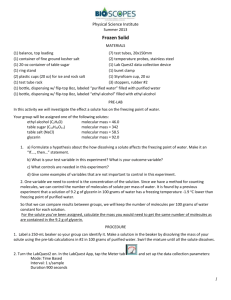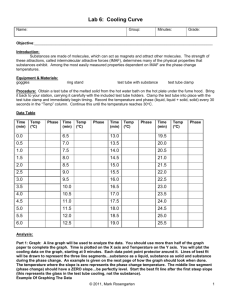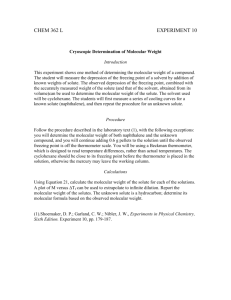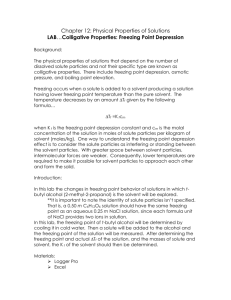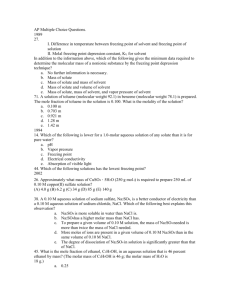Lab #13
advertisement
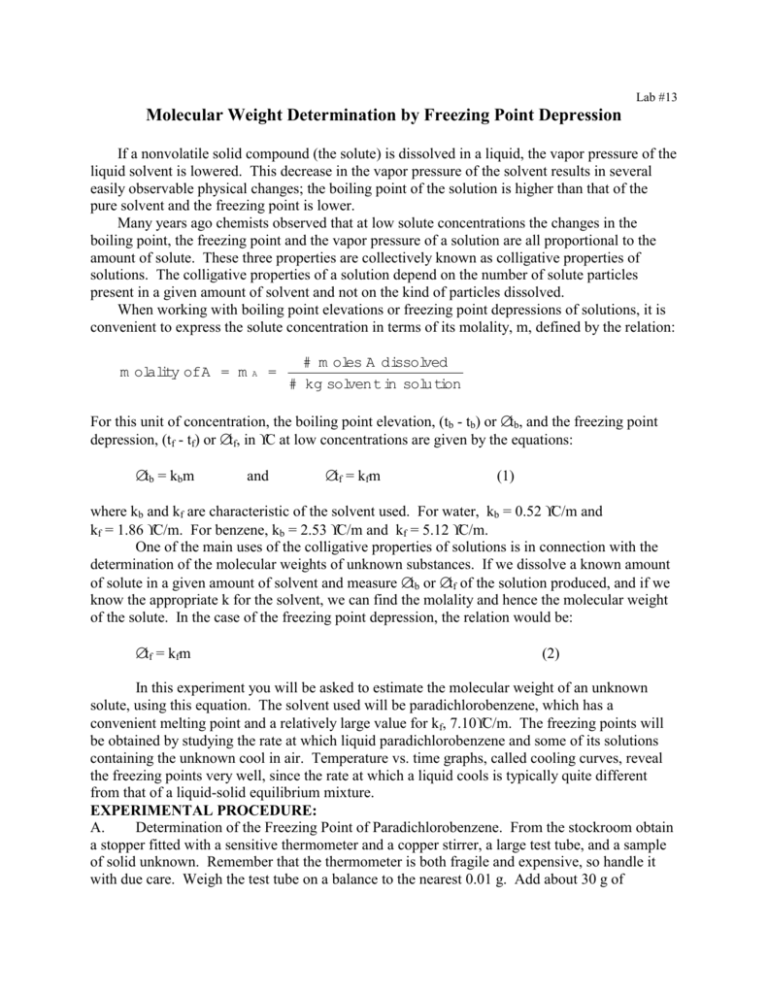
Lab #13 Molecular Weight Determination by Freezing Point Depression If a nonvolatile solid compound (the solute) is dissolved in a liquid, the vapor pressure of the liquid solvent is lowered. This decrease in the vapor pressure of the solvent results in several easily observable physical changes; the boiling point of the solution is higher than that of the pure solvent and the freezing point is lower. Many years ago chemists observed that at low solute concentrations the changes in the boiling point, the freezing point and the vapor pressure of a solution are all proportional to the amount of solute. These three properties are collectively known as colligative properties of solutions. The colligative properties of a solution depend on the number of solute particles present in a given amount of solvent and not on the kind of particles dissolved. When working with boiling point elevations or freezing point depressions of solutions, it is convenient to express the solute concentration in terms of its molality, m, defined by the relation: m olality ofA = m A = # m oles A dissolved # kg solvent in solution For this unit of concentration, the boiling point elevation, (tb - tb) or ∆tb, and the freezing point depression, (tf - tf) or ∆tf, in °C at low concentrations are given by the equations: ∆tb = kbm and ∆tf = kfm (1) where kb and kf are characteristic of the solvent used. For water, kb = 0.52 °C/m and kf = 1.86 °C/m. For benzene, kb = 2.53 °C/m and kf = 5.12 °C/m. One of the main uses of the colligative properties of solutions is in connection with the determination of the molecular weights of unknown substances. If we dissolve a known amount of solute in a given amount of solvent and measure ∆tb or ∆tf of the solution produced, and if we know the appropriate k for the solvent, we can find the molality and hence the molecular weight of the solute. In the case of the freezing point depression, the relation would be: ∆tf = kfm (2) In this experiment you will be asked to estimate the molecular weight of an unknown solute, using this equation. The solvent used will be paradichlorobenzene, which has a convenient melting point and a relatively large value for kf, 7.10°C/m. The freezing points will be obtained by studying the rate at which liquid paradichlorobenzene and some of its solutions containing the unknown cool in air. Temperature vs. time graphs, called cooling curves, reveal the freezing points very well, since the rate at which a liquid cools is typically quite different from that of a liquid-solid equilibrium mixture. EXPERIMENTAL PROCEDURE: A. Determination of the Freezing Point of Paradichlorobenzene. From the stockroom obtain a stopper fitted with a sensitive thermometer and a copper stirrer, a large test tube, and a sample of solid unknown. Remember that the thermometer is both fragile and expensive, so handle it with due care. Weigh the test tube on a balance to the nearest 0.01 g. Add about 30 g of paradichlorobenzene, PDB, (or fill the test tube between 1/2 and 2/3 full) to the test tube and weigh again to the same precision. Fill a 600 mL beaker almost full of hot water from the faucet. Heat the beaker on a hot plate. Clamp the test tube to a ring stand and immerse the tube in the water as far as convenient. Heat the water to about 70 to 75°C (Use a different thermometer for this measurement), at which point most of the PDB will melt. Insert the stopper-thermometer-stirrer assembly into the test tube, adjusting the level of the thermometer so that the bulb is 1 cm above the bottom of the tube, well down into the melt. When the PDB is at about 65°C, stop heating. Stir, to dissolve any remaining solid PDB. Carefully remove the test tube from the hot water and swing away from the hot plate. Dry the outside of the test tube with a towel. Record the temperature of the PDB as it cools in the air. Stir the liquid slowly but continuously to avoid supercooling. Start readings at about 60°C and note the temperature every 30 seconds for 10 minutes or until the solution has solidified to the point that you are no longer able to stir it. Near the melting point you will begin to observe crystals of PDB in the liquid, and these will increase in amount as cooling proceeds. In the figure below, we have shown graphical how the temperature of pure PDB will typically vary with time in this experiment. Keep your PDB for the second part of the experiment. Do not throw it away. B. Determination of the Molecular Weight of an Unknown Compound. Weigh your unknown in its container to the nearest 0.01 g. Pour about 2 g into the test tube of PDB and reweigh the unknown container. Heat the test tube in the water bath, as before, until the PDB is again melted and the solid unknown is dissolved. When the melt has reached about 65°C, remove the tube from the bath and swing it away from the heat. Dry the test tube, and let it cool as before. Start readings at about 55°C and continue to take readings, while stirring, for 10 minutes or until you cannot stir. The dependence of temperature on time with the solution will be similar to that observed for pure PDB, and the temperature of the solid-solution mixture will gradually fall as cooling proceeds. There may be some supercooling, as evidenced by a rise in temperature shortly after the first appearance of PDB crystals. The freezing point of the solution is taken as the temperature at which the two lines on the temperature-time graph intersect. See the figure on the previous page. Add another 2 g of your unknown to the PDB solution and again weigh the container. Melt the PDB as before, heating it to about 65°C before removing it from the water bath. Cool as before and follow the temperature for 10 minutes after 55°C. Graph your data on three separate graphs and determine the freezing points of the three liquids and from that data the molecular weight of your unknown. m = m olality = # m oles solute # kg of solvent (3) ∆t = freezing point of pure solvent - freezing point of solution g solute 1000 g kf g solvent 1 kg GM W = ∆t (4) (5) Alternate Procedure (Using the Labworks II Interface) Part 1 – Setting up the program 1) Make sure SW “X” on the Interface is in the down position. Also make sure that the Network/Operate Switch is in the operate (down) position. 2) Open the Labworks II program by double clicking on its icon on the Windows 95 Desktop. 3) 4) 5) 6) Click on the design button. Choose EZ program and Create new File. Click OK. If the options on line 3 say Time for Read and Time for Labeled, go to line 4. If not, choose Time from the Read drop down list and in the Labeled box, type in Time, then go to line 4. 7) On line 4, for the Read box, choose Temp 1 from the drop down list and change the labeled box to degrees C. 8) On line 6, for the Delay box choose 20 or 30 seconds from the drop down list. 9) Click on Acquire button at the top of the screen. 10) The program is now ready to collect data. Click on the start button at lower left of the screen, when you are ready to collect data. Part 2 – Freezing Point of Pure Phenyl Salicylate 1) Obtain a large test tube and weigh to the nearest 0.01 gram. Add about 30 grams of pure phenyl salicylate, PS, to the test tube and reweigh. 2) Fill a 600 mL beaker with tap water and heat it to 50-55°C on a hot plate. Clamp the test tube with the pure PS to a ring stand and immerse the test tube in the water as far as is convenient. When the PS is almost melted insert the copper stirrer and thermistor assembly. Make sure that the thermistor is immersed in the liquid PS. Use the stirrer to aid the complete melting of the PS. 3) When the Ps is all melted, carefully remove the test tube from the hot water and swing it away from the hot plate. 4) Dry the outside of the test tube with a towel. 5) Click the Start button on the computer screen to start recording time and temperature data. Be sure to keep stirring the liquid with the copper stirrer until it becomes too difficult to do so. Be careful not to bang the thermistor or damage it in any other way. If stirring is not done continuously a large amount of supercooling will be observed. 6) Continue taking measurements for 15 - 20 minutes or until a flat area on the graph is observed. 7) Stop the experiment by clicking the Stop button on the lower left of the screen. 8) Immerse the test tube in the hot water bath to remelt the PS. 9) Click on the Save button, insert a disk into the floppy drive, give a name to your file and save it on drive a. Part 3 - Freezing Point of Solution #1 Computer setup: 1) Make sure the SW”X” is in the DOWN position. 2) Click on design tab on computer screen. 3) Repeat steps 4 - 8 from Part 1 above. 4) Click on the start button when you are ready to start collecting data. 5) Weigh about 2 grams of your unknown to the nearest 0.01 g and add it to the melted PS. 6) Stir to completely dissolve. 7) Carefully remove the test tube from the water bath and swing it away from the hot plate. Dry the outside of the test tube. 8) Click on the start button to start recording data. Be sure to stir the solution continuously. 9) Repeat steps 6 – 9 from Part 2 above. Make sure you give a different name to this file. Part 4- Freezing Point of Solution #2 Computer setup: Repeat steps 1 - 4 from Part 3 above. 5) Weigh another approximately 2 gram sample of your unknown to the nearest 0.01 g and add it to the melted PS and stir to dissolve. 6) Repeat steps 7 - 9 from Part 3 above. Make sure you give a different name to this file. 11) Immerse the test tube in the hot water bath. When all the solution has melted, dispose of the solution and clean the equipment as directed by your instructor. Part 5 – Analyzing data and Printing Graphs 1) Using a computer connected to a printer, open the Labworks II program, if it is not already open. 2) Click on Analyze button at top of the screen. 3) Choose open an existing file and click OK. 4) Insert your floppy disk and select drive a: and open your file. 5) Click on Graph Setup menu at top of screen. Make sure the x-axis is your time column and the y-axis is your Temp column. Check the Grid Lines box. Under Graph type, select Point from the drop down list. Under Point type, select Circle from the drop down list. 6) Click OK. 7) Click on File Menu at top of screen. Select Print Graph. 8) Repeat these steps for all 3 of your files. CALCULATIONS: Determine the freezing points of the 3 solutions as shown in the lab manual. Enter this data along with the masses of the phenyl salicylate and unknown in the data table on page 98 of your lab manual. The kf of phenyl salicylate is 8.8 °C/ m. Using this value, calculate the average molecular weight of your unknown. Hand in pages 97 - 98 of your lab manual along with your 3 graph printouts. Don’t fill in the data columns and don’t hand in your data. Remelt and discard your mixture in the special receptical provided in the hood. Lab #13 Molecular Weight Determination by Freezing Point Depression Name ___________________________________________ Section ___________ DATA SHEET: Mass of large test tube Mass of test tube plus about 30 g of paradichlorobenzene Mass of container plus unknown Mass of container less Sample I Mass of container less Sample II ________________________ ________________________ ________________________ ________________________ ________________________ Time-Temperature Readings (taken to nearest 0.1°°C): TEMPERATURE Time (minutes) 0 0.5 1.0 1.5 2.0 2.5 3.0 3.5 4.0 4.5 5.0 5.5 6.0 6.5 7.0 7.5 8.0 8.5 9.0 9.5 10.0 Paradichlorobenzene ___________ ___________ ___________ ___________ ___________ ___________ ___________ ___________ ___________ ___________ ___________ ___________ ___________ ___________ ___________ ___________ ___________ ___________ ___________ ___________ ___________ Estimation of Freezing Point: Solution #1 ____________ ____________ ____________ ____________ ____________ ____________ ____________ ____________ ____________ ____________ ____________ ____________ ____________ ____________ ____________ ____________ ____________ ____________ ____________ ____________ ____________ Solution #2 ____________ ____________ ____________ ____________ ____________ ____________ ____________ ____________ ____________ ____________ ____________ ____________ ____________ ____________ ____________ ____________ ____________ ____________ ____________ ____________ ____________ Plot graphs of temperature vs. time readings for pure PDB and for each of the runs of the two solutions. If you plot all 3 graphs on the same graph, in order to avoid overlapping of the graphs, add 4 minutes to all observed times for pure PDB, and add 2 minutes to all times for Solution #1. The freezing point of the liquid may, in each case, be taken to be the point of intersection of the approximately straight line portions of the cooling curve. If you prefer, you may use a different sheet of graph paper for each set of data. Calculation of Molecular Weight: Solution #1 Solution #2 _____________ _____________ _____________ _____________ _____________ _____________ _____________ _____________ _____________ _____________ _____________ _____________ _____________ _____________ _____________ Mass of unknown used (total amount in solution) Mass of paradichlorobenzene used Freezing point of pure paradichlorobenzene Freezing point of solution Freezing point depression (total depression) Total molal concentration of unknown (Use equation 2) Molecular Weight Average MW Unknown # ________________ Lab #13 Molecular Weight Determination by Freezing Point Depression Name ___________________________________________ Section ___________ DATA SHEET for ALTERNATE PROCEDURE: Mass of large test tube Mass of test tube plus about 30 g of phenyl salicylate Mass of container plus unknown Mass of container less Sample I Mass of container less Sample II _______________ _______________ _______________ _______________ _______________ Estimation of Freezing Point: Plot graphs of temperature vs. time readings for pure phenyl salicylate and for each of the runs of the two solutions, using the3 Labworks II program. The freezing point of the liquid may, in each case, be taken to be the point of intersection of the approximately straight line portions of the cooling curve. Calculation of Molecular Weight: Solution #1 Solution #2 Mass of unknown used (total amount in solution) Mass of phenyl salicylate used Freezing point of pure phenyl salicylate Freezing point of solution Freezing point depression (total depression) Total molal concentration of unknown (Use equation 2) Molecular Weight Average MW Unknown # ________________ ___________ ___________ ___________ ___________ ___________ __________ __________ __________ __________ __________ ___________ ___________ ___________ __________ __________ Lab #13 PRESTUDY NAME ______________________________________ SECTION _____________ Determination of Molecular Weight by Freezing Point Depression 1. A student determines the freezing point of a solution of 0.867 g of an unknown sample in 28.25 g of benzene. The student obtains the following time-temperature data: Time (min) Temperature (°°C) Time (min) Temperature (°°C) Time (min) Temperature (°°C) 0 10.50 3 7.19 6 4.95 0.5 10.00 3.5 6.56 6.5 4.96 1 9.45 4 6.10 7 4.95 1.5 8.85 4.5 5.50 7.5 4.90 2 8.30 5 5.20 8 4.90 2.5 7.75 5.5 5.00 8.5 4.81 (a) Plot temperature vs. time on a graph. From the graph, estimate the freezing point of the solution to the nearest 0.01 °C, by determining the intersection of the two straight line portions of this cooling curve.(5 points) _______ (b) Assuming kf for benzene is 5.12 °C/ m and its freezing point is 5.48 °C, calculate the gram molecular weight of the unknown.(5 points) _______________




